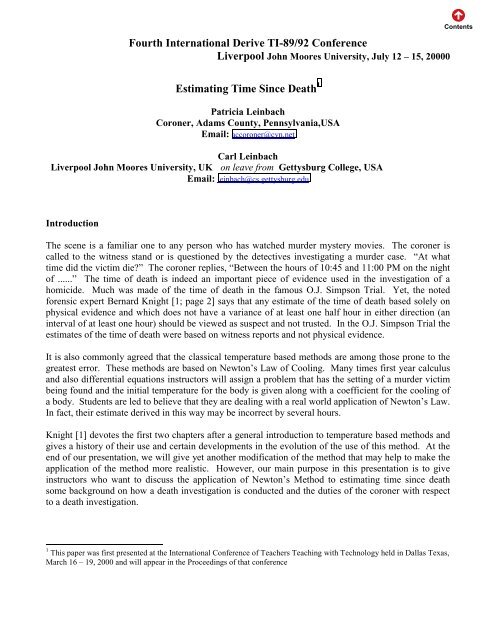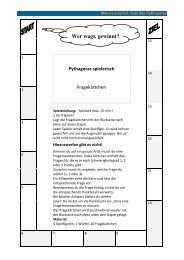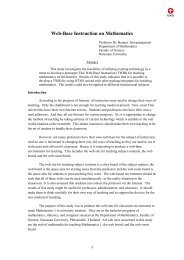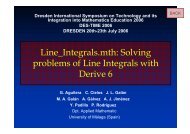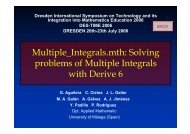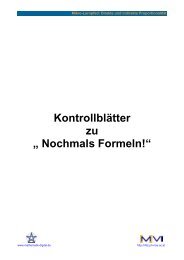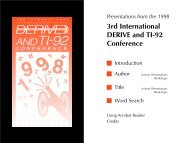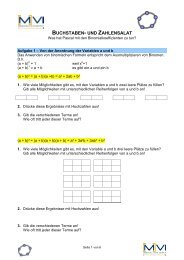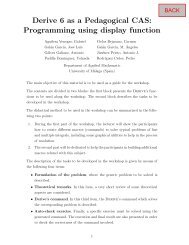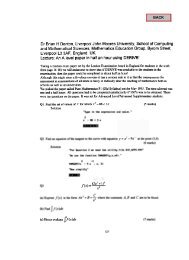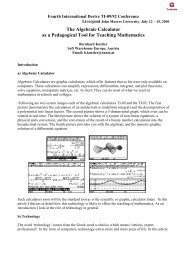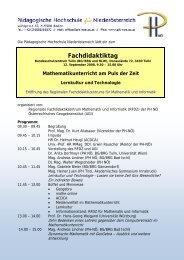Estimating Time Since Death
Estimating Time Since Death
Estimating Time Since Death
Create successful ePaper yourself
Turn your PDF publications into a flip-book with our unique Google optimized e-Paper software.
Fourth International Derive TI-89/92 Conference<br />
Liverpool John Moores University, July 12 – 15, 20000<br />
<strong>Estimating</strong> <strong>Time</strong> <strong>Since</strong> <strong>Death</strong> 1<br />
Patricia Leinbach<br />
Coroner, Adams County, Pennsylvania,USA<br />
Email: accoroner@cvn.net<br />
Carl Leinbach<br />
Liverpool John Moores University, UK on leave from Gettysburg College, USA<br />
Email: leinbach@cs.gettysburg.edu<br />
Introduction<br />
The scene is a familiar one to any person who has watched murder mystery movies. The coroner is<br />
called to the witness stand or is questioned by the detectives investigating a murder case. “At what<br />
time did the victim die?” The coroner replies, “Between the hours of 10:45 and 11:00 PM on the night<br />
of ......” The time of death is indeed an important piece of evidence used in the investigation of a<br />
homicide. Much was made of the time of death in the famous O.J. Simpson Trial. Yet, the noted<br />
forensic expert Bernard Knight [1; page 2] says that any estimate of the time of death based solely on<br />
physical evidence and which does not have a variance of at least one half hour in either direction (an<br />
interval of at least one hour) should be viewed as suspect and not trusted. In the O.J. Simpson Trial the<br />
estimates of the time of death were based on witness reports and not physical evidence.<br />
It is also commonly agreed that the classical temperature based methods are among those prone to the<br />
greatest error. These methods are based on Newton’s Law of Cooling. Many times first year calculus<br />
and also differential equations instructors will assign a problem that has the setting of a murder victim<br />
being found and the initial temperature for the body is given along with a coefficient for the cooling of<br />
a body. Students are led to believe that they are dealing with a real world application of Newton’s Law.<br />
In fact, their estimate derived in this way may be incorrect by several hours.<br />
Knight [1] devotes the first two chapters after a general introduction to temperature based methods and<br />
gives a history of their use and certain developments in the evolution of the use of this method. At the<br />
end of our presentation, we will give yet another modification of the method that may help to make the<br />
application of the method more realistic. However, our main purpose in this presentation is to give<br />
instructors who want to discuss the application of Newton’s Method to estimating time since death<br />
some background on how a death investigation is conducted and the duties of the coroner with respect<br />
to a death investigation.<br />
1 This paper was first presented at the International Conference of Teachers Teaching with Technology held in Dallas Texas,<br />
March 16 – 19, 2000 and will appear in the Proceedings of that conference
Fourth International Derive TI-89/92 Conference<br />
We begin with a brief discussion of the history of the coroner’s office and how the office is established<br />
in the state of Pennsylvania. We then proceed to the duties of the coroner, conduct of the coroner on<br />
the scene of an investigation, and the means used to estimate time of death. We conclude with the<br />
construction, testing, and application of a mathematical model for making a temperature based<br />
estimate.<br />
History of the Coroner’s Office<br />
While some mention of the office of Coroner may be found in earlier records, say during the reign of<br />
Alfred the Great, the office of Coroner as we know it today was instituted during the reign of Richard<br />
the Lionheart. Contrary to popular belief reinforced by the Robin Hood movies, Richard was not a<br />
good and kindly king. He was interested only in making war and spent little time in England. In his<br />
view, England was only a source of revenue. He and his wards instituted heavy taxes on the English<br />
and had Sheriffs in each “shire” to collect taxes and keep his coffers filled. The system was riddled<br />
with corruption – one true aspect of the Robin Hood films. Sheriffs were skimming much of the<br />
revenue for themselves, and the revenue was not flowing into the king’s coffers.<br />
It is also true that Richard was held in Germany for a huge ransom. His faithful minister Hugo Walter<br />
came to the Continent to arrange for a ransom, an amount of 150,000 marks which is equivalent to<br />
several million dollars in today’s terms. Walter who eventually became the Chief Justiciar and<br />
Archbishop of Canterbury was the de facto ruler of England (Richard only spent a total of four months<br />
there). He replaced many of the sheriffs, but realised that it was only a matter of time before the new<br />
sheriffs may emulate their predecessors. To keep money flowing into the King’s Coffers he revived the<br />
old office of the Coroner.<br />
The legal foundation of the office is recorded by Knight [2] in an extensive history of the office given<br />
on the Web. According to Knight:<br />
“Now the actual formation of the office of Coroner is based on an extremely skimpy<br />
base. The edict that formally established the Coroners was Article 20 of the "Articles of<br />
Eyre" in September 1194. The "General Eyre" was the periodic visitation of the King's<br />
itinerant Judges, who travelled slowly around the country dispensing what passed for<br />
justice in those days. It was the forerunner of the "Assizes", derived from the Norman-<br />
French for "sittings" which, in turn, of course, gave way to the present Crown Courts in<br />
more recent times. The Eyre of September 1194 was held in the County of Kent, and<br />
Article 20 baldly stated that:<br />
"IN EVERY COUNTY OF THE KING'S REALM SHALL BE ELECTED<br />
THREE KNIGHTS AND ONE CLERK, TO KEEP THE PLEAS OF THE<br />
CROWN"<br />
And that is the only statutory basis for the Coroner. Each county had three Coroners and a<br />
poor man who had to walk behind their horses, carrying the "Coroners' Rolls" and pen and<br />
ink: a Medieval Coroner's Officer, you might call him; though even this minor office was<br />
abolished in later years to provide for another Coroner. Now the above words are the only<br />
official authority for the long-lived system and, looking at the remit of the new Coroners,<br />
Leinbach, P. & Leinbach, C. Page 2
Fourth International Derive TI-89/92 Conference<br />
they were ordered only to "keep the pleas of the Crown". This meant recording the pleas on<br />
parchments known as the "Coroners' Rolls," many of which survive today in the Public<br />
Record Office.<br />
"Keeping the pleas" was quite different to "holding the pleas" which meant actually trying<br />
the cases and passing sentence. This could only be done for lesser offences at the County<br />
Courts by the Sheriffs, otherwise the cases had to be committed to the next General Eyre<br />
when it trundled along in the fullness of time - which might be years ahead. In fact both<br />
Coroners and Sheriffs did, in the early years, hold pleas of the Crown, acting as Judges in<br />
an ultra vires fashion. Consequently, one of the demands of Magna Carta, some twenty<br />
years later, expressly forbade this practice. Chapter 24 of Magna Carta states: "No sheriff,<br />
constable, coroner or bailiff shall hold pleas of our Crown".<br />
The keeping of the pleas of the Crown was the source of the title, the original Latin was<br />
"custos placitorum coronas" from which the word "coroner" is derived. He was referred to<br />
for hundreds of years as "the Crowner" - as in Shakespeare's Hamlet, where derisively it is<br />
said "But is this law? Ay, marry, is't crowner's quest law!"<br />
So the office was established and named. The requirement of being a knight gave way to being<br />
among the most “meet and lawful men of the county.” However, the main duty was to see that the<br />
King received his just income from the population, his subjects. One of the large sources of income<br />
was any death that occurred in the county, and death investigation, the only remaining duty of the<br />
Coroner, whether suspicious, accidental, or natural became an important duty of the Coroner. The<br />
Coroner was to establish the circumstances surrounding the death. The General Eyre which<br />
reviewed the records perhaps years later then could fine the population for any wrong procedures.<br />
Thus, the keeping of accurate records was essential to the Coroner’s duties as well as the Crown’s<br />
income.<br />
The Office of the Coroner became firmly established in the English Civil and Jurisprudence system<br />
and has evolved to the Office as we know it today. It was brought to the Colony of Pennsylvania, or<br />
“Penn’s Woods” with the early settlers. In the late 1600’s the procedure for filling the office was<br />
that the freemen of each county annually nominated two individuals and the governor appointed one<br />
of them. The Constitution of 1776 continued the annual appointment, but the Constitution of 1790<br />
provided for a three year appointment. In 1838 the office became elective. In 1909 the term was<br />
extended to four years.<br />
The duties of the Coroner have remained as defined in the 1680’s and recorded in the Pennsylvania<br />
State Archives records on County Offices [3]. The Coroner is responsible for investigating sudden,<br />
suspicious, or violent deaths in the county. The duties of the Coroner are to issue certificates<br />
indicating probable cause of death, holding inquests if necessary, and overseeing the county morgue.<br />
Pursuant to these duties the Coroner is authorised to have autopsies performed, hold inquests,<br />
summon jurors and subpoena witnesses. The Coroner’s records are usually to include dockets and<br />
investigatory files generally consisting of autopsy and toxicology reports, correspondence,<br />
inquisition sheets, lists of personal effects, notes, photographs, and summary reports.<br />
Leinbach, P. & Leinbach, C. Page 3
Fourth International Derive TI-89/92 Conference<br />
The requirements for holding the office of Coroner are that the person be 21 years of age and a<br />
United States Citizen. The Coroner must be elected by the citizens of the county and must be a<br />
resident of the county for one year prior to election. Recently a requirement has been made that the<br />
Coroner must take a course of one week in length at the State Police Academy or have equivalent<br />
training. Prior to assuming office the Coroner must pass an exam administered by the State Attorney<br />
General’s Office. Once in office the Coroner may appoint Deputies that have the same power as the<br />
Coroner. The Deputies are approved by the County Commissioners.<br />
The Certificate of <strong>Death</strong> issued by the State and signed by the Coroner requires that a date of death<br />
be established. It also requires that the Coroner establish a manner and cause or the death. It may be<br />
important in establishing these facts that a time of death be established. This time may also be useful<br />
in any ensuing investigation by law enforcement officials.<br />
The Coroner on the Scene of a <strong>Death</strong> Investigation<br />
<strong>Since</strong> the duties of the office of Coroner require the establishment of the manner and cause of death, (Is<br />
this an accidental death, natural death, suicide, or homicide?) and these determinations can have<br />
profound effects, it is essential that the Coroner have full charge of the scene of a death. This includes<br />
having authority over and the use of emergency services’ personnel, police, and other people in<br />
attendance at the scene. The Coroner needs to develop a clear picture of the scene and all facts related<br />
to the death of an individual. She needs to know in what way the scene has been altered by the<br />
entrance of investigating officers and emergency personnel. Pictures need to be taken. Onlookers and<br />
witnesses need to be questioned and facts concerning the case need to be determined.<br />
The Coroner needs to take charge of the possessions of the deceased until they can be dispersed to a<br />
responsible family member or an appropriate individual. In general, it is the Coroner’s duty to uphold<br />
the rights of the deceased or to put it in a more popular phrase, “to speak for the deceased.” A large<br />
part of this responsibility is to guarantee that all facts related to the death of the individual are known.<br />
Thus, the Coroner must complete a thorough and rigorous investigation of the circumstances<br />
surrounding the death. This may include the best possible estimation of the time of the death.<br />
In addition to protecting the rights of the deceased, the Coroner needs to complete public documents<br />
and meet the public’s “right to know.” This means that the Coroner must respond to reasonable<br />
requests by the public press and be prepared to present evidence at any legal inquiries. The Coroner<br />
generally needs to co-operate with investigating authorities and not obstruct them in their<br />
investigations. At the same time this co-operation needs to be balanced with the need to protect the<br />
rights of the deceased and the family of the deceased. Sometimes the protection of these rights may be<br />
set by law, such as in the case of HIV infection or other diseases where the rights of privacy of the<br />
deceased are involved.<br />
Means of <strong>Estimating</strong> <strong>Time</strong> of <strong>Death</strong><br />
There are several means for estimating the time of death. Of course if the event is witnessed, the time<br />
of death can be established with accuracy. This is true in the hospital setting, an attended death at<br />
Leinbach, P. & Leinbach, C. Page 4
Fourth International Derive TI-89/92 Conference<br />
home, or many times in the case of many motor vehicle accidents and other accidents such as industrial<br />
or work related accidents. In other cases witness encounters with the deceased prior to and after death<br />
can be used to set bounds on the time of death. One, somewhat humorous, situation occurred when the<br />
second author made a rough heat loss based estimate for the first author, and she replied, “That can’t<br />
be, the person was seen alive by a friend two hours after that time.” Such is the problem with using<br />
mathematical equations to establish the time of death.<br />
One, reasonably accurate estimate in the case of a fairly recent death is to measure the potassium level<br />
in the vitreous fluid of the eye. It this level is denoted as Kv, then the formula:<br />
7.14 × Kv − 39.1<br />
gives a reasonable estimate during the first nine and one half hours after death. Of course, obtaining the<br />
vitreous fluid is a medical procedure and is generally done at a place other than the scene of the<br />
incident.<br />
There are several physical signs that can assist the Coroner in establishing bounds on the time that has<br />
elapsed since the time of death. The following is a list of a few of these signs. For the most part they<br />
are used to check consistency of other methods.<br />
Sign Lower Bound (Hrs.) Upper Bound (Hrs.)<br />
Tendon reflexes present 0 2<br />
Dried Blood (wounds) estimate from<br />
drying at periphery inward ½ 4<br />
Livor mortis-mild (pink coloration at<br />
lower portions of the body) ½ 4<br />
Livor mortis-livid 8 12<br />
Rigor mortis-onset (subtract one hour for<br />
each 10 o F above or below 70 o )<br />
Jaw muscles 2 6<br />
Neck and fingers 3 7<br />
Wrists 4 8<br />
Elbows 5 9<br />
Shoulders and knees 6 10<br />
Hips 7 11<br />
Abdomen (complete rigor mortis) 8 12<br />
Rigor mortis disappearance (subtract one<br />
hour for each 10 o F above 70 o and<br />
add one hour for each 10 o below 70 o<br />
Jaw muscles 26 30<br />
Neck and fingers 27 31<br />
Wrists 28 32<br />
Elbows 29 33<br />
Leinbach, P. & Leinbach, C. Page 5
Fourth International Derive TI-89/92 Conference<br />
Shoulders and knees 30 34<br />
Hips 31 35<br />
Abdomen (complete rigor mortis) 31 36<br />
There are other physical signs that can also be used, but the above table gives some of the most used<br />
signs. As can be seen these signs do not give exact times and really, as previously mentioned, only<br />
establish bounds and give credibility to other measurements.<br />
This brings us to the issue of using a temperature-based method and the use of Newton’s Law of<br />
Cooling. There are several sites that have been used over the years. Some used a measurement of skin<br />
temperature because of the non-invasive nature of this technique. However, the measurements are<br />
affected by changes in ambient conditions, the size and age of the patient, the amount of clothing worn<br />
by the patient, etc. In general these measurements have a tendency to be inaccurate. Another only<br />
mildly invasive site is the rectum of the victim. Knight [1] points out that in many cases there is<br />
actually a rise in the measured body temperature after death using this site. The reason for this is the<br />
fact that the organs of the body discharge heat immediately after death. This is partially due to the<br />
inhomogeneous nature of the body and the fact that heat escaping from the various organs will take a<br />
most direct route. Knight advocates the use of trachea measurements, but this is not easily<br />
accomplished in the field.<br />
A sight that is a homogeneous organ, whose access is only mildly invasive, and that can be accessed<br />
with relative easy in the field is the liver of the deceased. It is accessible via a small incision made in<br />
the abdomen and a stainless steel heat probe similar to that used in the new CBL2 kit. The liver is a<br />
protected organ and tends to loose heat in a uniform way. It is not as subject to the other confounding<br />
influences as the other methods tend to be. The standard procedure is to monitor the temperature at<br />
intervals of 15 minutes to establish the cooling characteristics of the organ for the individual person.<br />
Having discussed the general nature of a death investigation and the obtaining of information that can<br />
be used to estimate the time since death, we will proceed to a modelling technique which can be applied<br />
to the data gathered by the coroner.<br />
A Mathematical Model Based on Heat Loss<br />
Many of us have at some time or other run the following temperature experiment in some of our<br />
classes. We have a cup of hot liquid. Many instructors use their cup of coffee to insert a bit of a<br />
personal touch into the class. Then as we are developing the solution of the differential equation<br />
resulting from Newton’s Law of Cooling, we have a temperature probe in the cup of liquid measuring<br />
the temperature of the liquid at precisely spaced intervals. At the conclusion of the exegesis and the<br />
experiment, the theoretical and experimental results are compared. Usually the experiment is run for<br />
times anywhere from one half to one hour. The comparison of the theoretical and experimental results<br />
is generally very impressive.<br />
Leinbach, P. & Leinbach, C. Page 6
Fourth International Derive TI-89/92 Conference<br />
Below are the results of an experiment that was run in a kitchen with time measurements being made<br />
every 90 seconds. On the left is the data as it was gathered and on the right is a plot of the data together<br />
with the graph of an exponential function obtained by doing a least squares fit of the observed<br />
temperatures less the ambient temperature versus time.<br />
As is noted in the figure on the left the ambient temperature was 19.5 o C. The regression equation for<br />
the given data is T(t) = 53.25 * .995298 t + 19.5 Taking the natural logarithm of .995298 and<br />
considering Newton's Law of Cooling with a constant temperature<br />
dT<br />
=−.00047( T −19.5)<br />
dt dT<br />
= kT ( −T)<br />
dt<br />
We have the differential equation:<br />
Using the Differential Equations mode of the TI - 92 plus we plot the slope field and the data points.<br />
We graph a numerical solution starting at one of the intermediate data points and observe that the<br />
agreement with the experimental data is uncanny.<br />
This is one of the reasons we use this experiment in our classes. It gives a good solid application of the<br />
solution of the differential equation to the real world phenomenon that the class observed.<br />
But, what about the application of this differential equation to different situations? The equation given<br />
above assumes a constant ambient temperature. What if the ambient temperature varies as the body is<br />
cooling? In this case we have a non-linear differential equation and an analytic solution may not be<br />
possible. For example, suppose the coroner is called to the scene of a body found outside and the last<br />
time the person was seen was several hours previous to the discovery of their body? For example,<br />
suppose an individual left a group of friends at midnight and was declared missing some hours later.<br />
The person’s body was found in a park the following evening and the coroner arrives at 8PM.<br />
Temperature data exists for from midnight until the time of discovery. Here is a graph of the ambient<br />
temperature data. Note that measurements were only taken every two hours.<br />
Leinbach, P. & Leinbach, C. Page 7<br />
a
Fourth International Derive TI-89/92 Conference<br />
The range on this graph is from 25 o F to 45 o F. We use the Fahrenheit scale here because of the fact<br />
that we will eventually be asking when was the body temperature 98.6 o F? Obviously, we can not<br />
assume that the body cooled under the condition of a constant ambient temperature. We will use the<br />
differential equation for Newton's Law of Cooling in this case, but in a highly non-linear form. The<br />
numeric differential equations solver of the TI - 92 plus will, however, be able to handle the equation.<br />
Prior to discussing our hypothetical case, we will first run one more experiment. It will be a stepping<br />
stone between our original experiment and the coroner's problem. For this experiment, once again a<br />
cup of liquid is used, but the cooling conditions are varied. Six cooling strategies are employed during<br />
the 54 minute cooling period. First the liquid is cooled as before in the ambient surroundings of 19.5 o<br />
C. Then the vessel is put into a water bath at 11.2 o C. Next it is placed in the refrigerator at 3.5 o C, the<br />
freezer at -7.5 o C, and finally, returned to the refrigerator. During each of the ensuing time periods the<br />
ambient temperature remains constant. Thus, we can use a standard exponential regression to describe<br />
the temperature of the liquid during each of these periods. However, for the differential equation<br />
model, we will use a piecewise-defined function for the ambient temperature given over the entire<br />
period.<br />
We first graph the data as it was collected and then show the differential equation model.<br />
We need to say a word about region 2 of this graph. This is during the time when the vessel of liquid<br />
was placed in a water bath. The bath was crudely constructed with a baking dish in a sink with the cold<br />
water running very slowly. Some of the water very likely splashed into the vessel of liquid changing<br />
the cooling characteristics of the liquid. This accounts for region 2 having a more pronounced slope<br />
than the other parts of the graph. We needed to account for the different cooling characteristics in the<br />
description of the differential equation for the cooling. Here is our non-linear model for the process.<br />
y' = chi(t,0,694)*-.000775(y − 19,5) + chi(t,695,1349)*-.002583(y − 11.20) +<br />
chi(t,1350,1979)*-.0005(y − 3.5) + chi(t,1980,2789)*-.00046(y + 7.5) +<br />
chi(t,2790,3240)*-.0006(y − 3.5)<br />
Leinbach, P. & Leinbach, C. Page 8
Fourth International Derive TI-89/92 Conference<br />
Note how the cooling characteristics of the liquid changed during the water bath and after the water<br />
bath. Previous to the water bath k had a value of −.000775. After the water bath it was closer to<br />
−.0005. This points to sloppy experimental procedure, but one which serendipitously gives us a more<br />
interesting function to consider. Here is the graph of the slope field and a numerical solution starting<br />
with our initial temperature reading<br />
The agreement with the data is not exact, but it is quite close and justifies our confidence in using this<br />
method for solving the coroner's problem.<br />
Let's return to the coroner's case. The victim was last seen alive at 12 Midnight and the body is found<br />
much later. The coroner arrives on the scene at 8PM. She takes a liver temperature of 70 o F and takes<br />
further temperatures at 15-min intervals for an hour to establish the cooling characteristics of the liver.<br />
Her data will justify a value of k = − .03. This is basically all that can be done on the scene relative to<br />
determining a temperature-based estimate of the time since death. Upon returning to her office she is<br />
able to get temperature data from her local weather station. She hands all of her data to a<br />
mathematician for analysis.<br />
The data is placed in a table and a linear interpolation formula is developed to describe the temperature<br />
function over the 24-hour period since the victim was last reported to be alive. (Note we only need it<br />
over a 20-hour period, but we use all of the data). This function is shown in the graph above that<br />
follows the first mention of the problem.<br />
Using this function we set up the differential equation: y' = − .03(y − am1(t)) where am1(t) is the<br />
function interpolating the temperature data. The data and the graph of the slope field which include a<br />
graph of the numerical solution of the coroner's data shown below. We can also see from the trace the<br />
approximate time when death occurred.<br />
Leinbach, P. & Leinbach, C. Page 9
Fourth International Derive TI-89/92 Conference<br />
From this result we can assume that the death occurred somewhere around 4AM. Once again, we stress<br />
that this is only a rough estimate. Other evidence will need to be considered to support our finding. If<br />
the victim came to a violent end, it gives investigators an interval, say from 3AM to 5AM, to begin<br />
questioning the whereabouts of suspects and possible material witnesses.<br />
References<br />
1. Knight, Bernard (editor), The Estimation of the <strong>Time</strong> <strong>Since</strong> <strong>Death</strong> in the Early Post-Mortem Period;<br />
Edward Arnold, Great Britain, 1995,<br />
2. Knight Bernard, “History of the Medieval Coroner System” as found on the World Wide Web at the<br />
URL http://www.britannia.com/history/articles/coroner1.html<br />
3. Pennsylvania State Archives – County Offices, as found on the World Wide Web at the URL<br />
http://www.state.pa.us/PA_Exec/Historical_Museum/DAM/rg/offices.htm<br />
Leinbach, P. & Leinbach, C. Page 10


